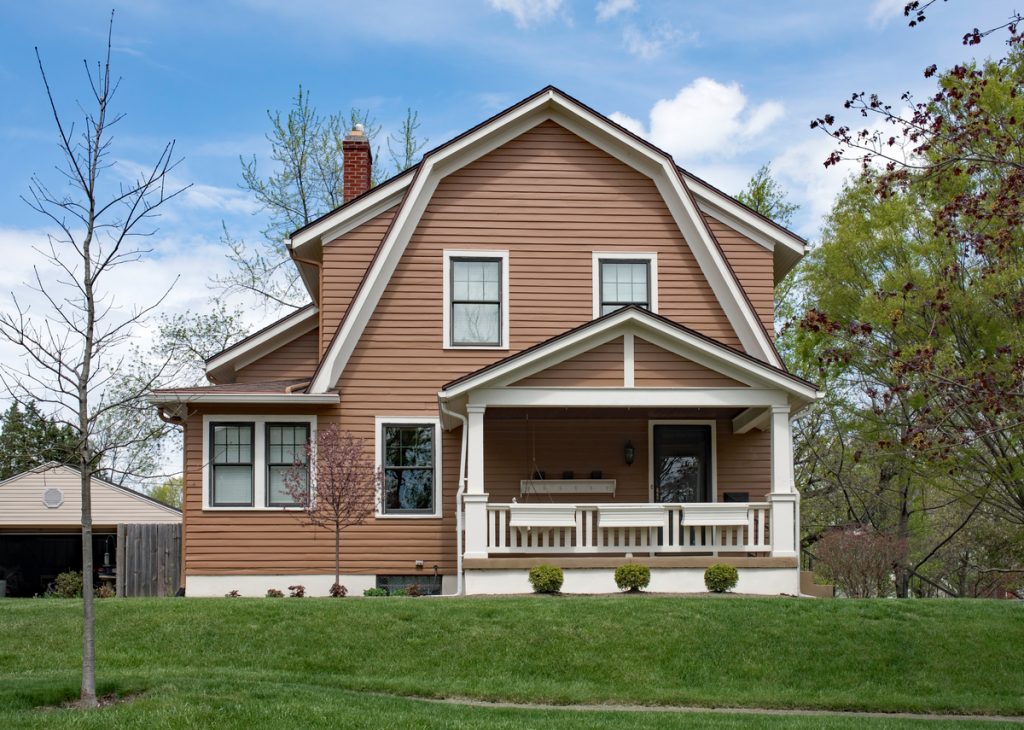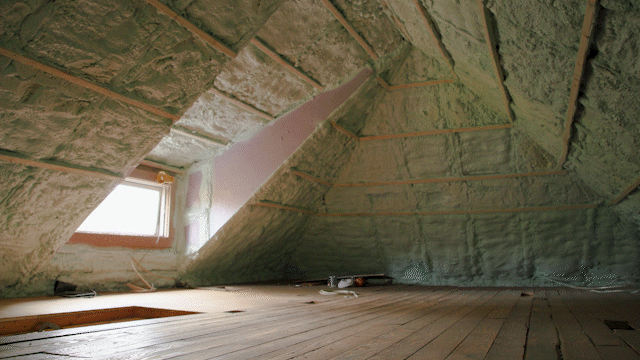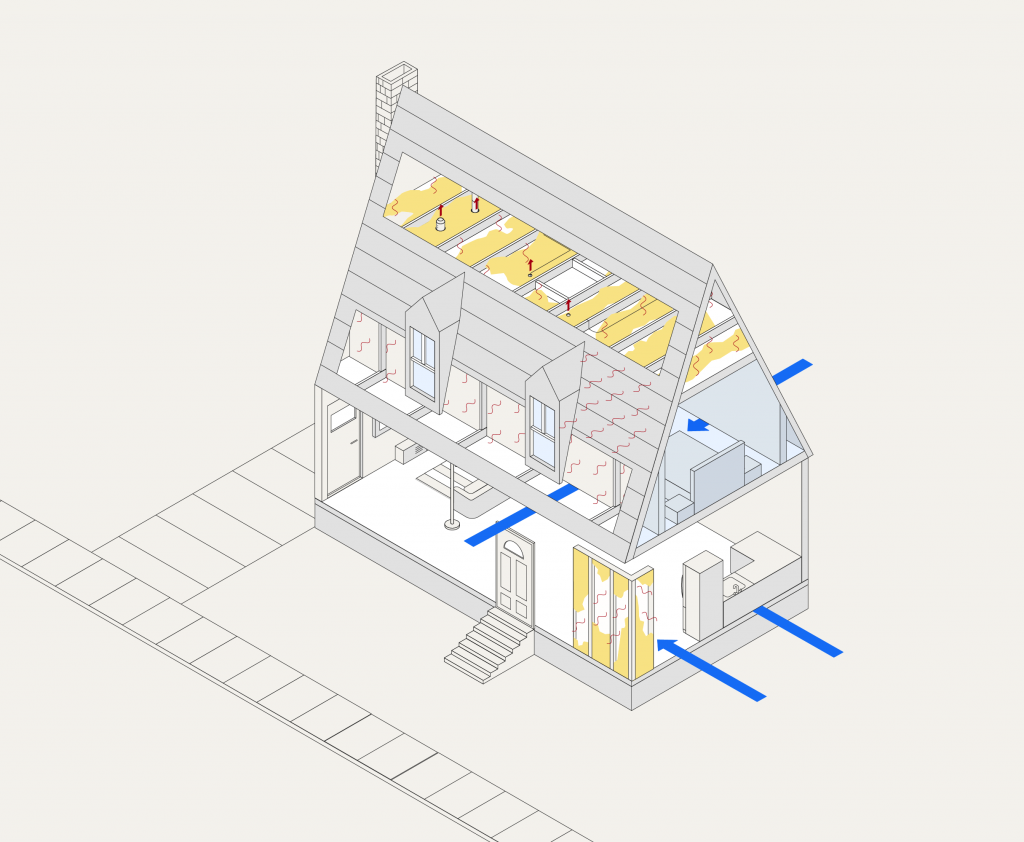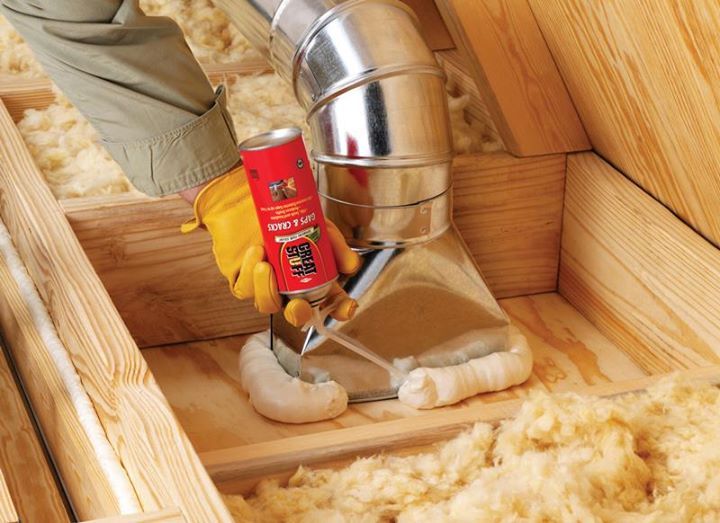How many attics do you have? You may have more than you think! Get the scoop on attic types and insulation considerations in this guide.
Every house has its mystery spaces.
Tucked behind little hidden doors and often hard to access, these nooks, crannies, and “mini rooms” are easily ignored—and sometimes totally hidden.
This may be why homeowners are often stumped by the question, “How many attics do you have?”
Many homeowners believe they have only one.
But there are actually different types of home attics (in addition to that big one upstairs). And these attics can play a huge role in your home’s comfort and efficiency.
Knowing how many attics you have is essential in understanding your home’s attic insulation needs.
Proper attic insulation is a key factor in your house’s comfort, indoor air quality, heating and cooling efficiency, cutting energy waste, and lowering your carbon footprint.
How many attics do you have? Read on to learn about the types of attics and why they matter.
But here’s one last thing to know before diving in: Depending on where you live, you could get powerful insulation upgrades at no upfront cost with Sealed. Tap here to see if you qualify.
Table of contents:
- What types of attics are there
- Do all houses have attics?
- How to tell if your house has an attic
- Why attics are so vital to home comfort and efficiency
- How much attic insulation is needed?
- Where to insulate and air seal your attic
- Can you insulate your attic yourself?
- Attic insulation tax credits and rebates
- How to get insulation and air sealing for your attic at no upfront cost

Types of attics found in homes
When it comes to attics, it’s all about framing. Some attics are too tiny to stand in. Some have peaked or sloped roofs, spacious enough for a fully furnished bedroom or other livable space.
But no matter the house, it’s important to know what sort of attic you’re working with.
That’s because an attic’s structure and measurements have a lot to do with how comfy, cozy, and efficient the rest of your house is.
So let’s dig into the many types of home attics and what each of them means for your house. Here’s a quick list, and we’ll dive in deeper below:
- Finished vs unfinished attics
- Knee wall attics
- Devil’s peak attics
- Flat roof (or almost no attic)
- Scuttle attics
First off, we’ll break down the difference between a fully finished attic and an unfinished one.
Finished vs. unfinished attics
What is considered a finished attic?
Well, an attic is considered finished when it meets the criteria for being livable and you can get to it from the inside of your home. So basically, it has to be appraisal-approved.
But what does that even mean? The American National Standards Institute (ANSI) says that finished attics must meet the same standards as the rest of the house (1). For example, if you have a working air conditioner in the rest of your home, you’ll also need it in your attic.
Why does it matter?
Not all attics have the potential to be finished. That’s because they must be at least 70 square feet overall and measure at least 7 feet in any direction (to be up to code).
If a room has a sloped ceiling (which is pretty common in attics) at least 50% of the room area has to have a 7-foot ceiling (2).
Depending on the size and shape of your unfinished attic compared to the rest of your home, you may not be able to meet the code to count a finished attic as additional square footage.
Any homeowner can finish their attic as long as you follow ANSI codes. But keep in mind that finishing an attic can cost a pretty penny—in some cases, up to $80,000 (3).
If you do decide to finish your attic though, you’re looking at a great return on your investment.
Upgrading your attic to a living space can even raise your home’s value by up to 53% (4)!
Can you upgrade the insulation in a finished attic?
It’s definitely possible to upgrade the insulation in a finished attic. However, the method for upgrading a finished attic’s insulation varies. Usually though, insulation in finished attics is installed between the ceiling rafters and studs of exterior walls.

Knee wall attics
What is a knee wall attic?
Also known as a side attic, these spaces are located at the point where your roofline meets the uppermost portions of your walls. They’re usually found connected to one or more of the bedrooms upstairs and are especially common in Cape Cod-style houses.
If you have one in your house, you could use it as an extra storage space or just ignore it altogether.
Why does it matter?
Knee attics are most often uninsulated and lack proper air sealing. This can make your second floor super hot in summer and cause second floor bedrooms and permanent staircases to feel like ice boxes during the winter because there isn’t a proper thermal boundary separating these semi-outdoor spaces from your living areas.

Can you finish a knee attic? Or do you need to leave it unfinished?
Knee walls can be finished or unfinished. If you do decide to finish it, the exact height of your knee wall is totally up to you.
Devil’s peak attics
What is a devil’s peak attic?
Don’t let the name scare you. Devil’s peak attics are actually just small attics partially covering the ceiling of the second floor of a house.
All or most of these kinds of attics are unfinished. And they’re also very common in Cape Cod-style homes.
Why does it matter?
A devil’s peak attic is often inaccessible to the homeowner, so it’s rarely properly air sealed and insulated.
This means that there is little to no thermal boundary between the ceiling of your second-floor rooms and the roof.
As a result, these rooms are too hot in the summer and heat escapes easily in the winter. And when heat escapes your top floor in the winter, it causes damaging ice dams. Learn how to prevent ice dams here.
Can you finish a devil’s peak attic? Or do you need to leave it unfinished?
Devil’s peak attics are unfinished, and they’ll probably need to stay that way since they’re inaccessible. But proper insulation and air sealing upgrades to a devil’s peak attic can increase your comfort, HVAC system efficiency, and cut energy waste.
Flat roof (or almost no attic)
What is a flat roof? Is there still attic space hidden somewhere?
We’d like to introduce you to the anti-attic: the flat roof. A flat roof is a top-floor ceiling with just a small, rectangular cavity above it and below the roof.
Why does it matter?
Without air sealing and insulation, a flat roof can be a major source of heat loss in winter. In summer, with the sun beating down on the roof, heat radiates into the rooms below.
Can you insulate or expand a flat roof? Or do you need to leave it as-is?
To insulate a flat roof often requires demolition, so we tend to recommend leaving it alone unless absolutely necessary.
Scuttle attics
What is a scuttle attic?
“Scuttle” simply means “hole.” So a scuttle attic is a small hole or access point in the ceiling, usually covered with a moveable drywall section called a hatch.
Scuttle attics are also known as ceiling attic doors. They tend to be found in closets or hallways and probably require a ladder to reach.
Why does it matter?
Scuttle attics are mainly needed as an access point for maintenance. Sometimes though, you can use them as storage. Think of them as portals for home maintenance, like bathroom fan upgrades, ventilation projects, and insulation and air sealing…
Can you finish a scuttle attic?
Since scuttle attics are so small, there’s really no way to finish them.
Wait—Do all houses have attics?
An attic is any space between the roof and the highest floor of a house, so technically speaking, more homes have this than not.
Imagine any kids’ drawing of a house (square bottom, triangle top—you know the deal). You’re more than likely going to see an attic. But believe it or not, art doesn’t quite imitate life in this instance.
Not today, anyway, as plenty of homes don’t have typical attics.
However, if you do have an attic—or plan to purchase a home with an attic—you better be prepared to make sure it has good insulation. An under-insulated attic means energy waste.
How do I know if my house has an attic?
Well, the first thing you need to know is, what does an attic look like? Technically, an attic is any space in a house that is between the roof and the top floor.
Make note of any hatches or tiny doorways you see around your house because they may lead to exactly that: an attic!
If you find an entrance to an attic, it doesn’t mean that your attic is spacious enough for you to enter—or that it’s even large enough to fit a box or two.
If you’re having trouble finding your attic (or if you have hidden attics—and many homes do!), we can help you scope it out, along with other nooks and crannies in your home that may be affecting your insulation. Call us at 917-905-3788.
Are there houses without attics?
This is a tricky one. Odds are, you probably have at least some space (or spaces) between your roof and ceiling.
There are two main kinds of roof structures you might think of when it comes to home attics: homes with rafters and homes with roof trusses.
Rafters are usually understood to be traditional attics, whereas more modern roof trusses aren’t. Which do you have?
- Rafters: They’re installed one lumber “stick” at a time, so sometimes they’re called a “stick-framed” roof accordingly. You know you have this kind of attic if it’s spacious enough for storage or even a living space.
- Roof trusses: These attics have web framing that connects the top chords of the space to the bottom. Unlike an attic with rafters, trussed roofs are no good for storage. They’re much smaller, and they’re also not engineered to hold heavy loads.
Why do houses have attics? What is the purpose?
Technically, there’s no house code requirement that says you have to have an attic.
So you might be wondering, what’s the point? Well, attics serve a few purposes.
- Attics can be great for extra storage. Got more holiday decorations than you know what to do with?? Throw them in the attic until next year.
- Your attic can be a whole extra room. If your attic is finished, you can use it as an extra bedroom, office, or even entertainment room. The possibilities are endless.
The main reason attics are useful is for whole-home ventilation. Attics can play a big role in your home’s air circulating properly and your house staying comfortable.
That’s why proper attic insulation and air sealing is so important. These upgrades could even slice your monthly energy bills by 15% or more (5).
Here’s why attics are vital to your home’s overall comfort and efficiency
To really understand the power of a home’s attic, let’s get to know a little concept called the stack effect.
Want to know what hot air balloons and your house have in common? The same force that makes a hot air balloon rise is what causes your home to feel uncomfortable and waste a lot of energy. It’s the stack effect!
In the winter, heated air in your home rises. When it does, it creates a vacuum that causes cold air to be sucked into your home via tiny air leaks (they may be small, but they add up to big ventilation and heat escape problems).
When your attic is poorly insulated and hasn’t been air sealed, heated air then is pushed out the top of your home and attic… causing your home heating system to be overworked and inefficient.

Air sealing and insulating your attic stop heat from escaping your home in winter… and keep heat from entering your home in summer.
For a quick visual of how attic insulation and air sealing work together to keep outside air out, check out the video below.
Basically, if you don’t care for your attic and insulate it properly, it turns into an oven that radiates heat into your living space in the summer.
And in winter? A poorly insulated attic allows paid-for heat to escape right out of the top of your roof. Get an expert to fix this problem at no upfront cost. Learn how.
A poorly insulated attic that hasn’t had professional air sealing increases:
- Ice dams on your roof (and a shorter roof life!)
- A cold, drafty house
- Uneven temperatures throughout your home
- HVAC system inefficiency
#1: Ice dams on your roof
If you live in an area that gets at least one significant snowfall per year, you’ve probably seen an ice dam before.
They cause lasting damage to your roof, moisture intrusion into your attic and interior walls, and can even pull the gutters straight off your house. But there are a few ice dam solutions that can permanently fix the problem—including upgraded attic insulation.
#2: A cold, drafty house
Just because you live in an older home doesn’t mean it should be cold and drafty. Under-insulated and unsealed attics can cause a drafty house, but professional air sealing and insulation are the final fixes you need to feel comfortable all year long.
#3: Uneven temperatures throughout your home
Is your upstairs floor too hot in the summer? And your downstairs floor too cold in the winter? Do you have just one room that never seems to get to a comfortable temperature, no matter what time of year it is?
Under-insulated attics are often to blame, because they’re a key component to creating a thermal boundary for your home as well as proper ventilation throughout your house. But you can fix a cold house—it’s true! And attic insulation can help.
#4: HVAC inefficiency (and decreases your HVAC’s lifespan)
Poorly insulated attics that haven’t been properly air sealed are a big contributor to big heating and air conditioning bills and high energy waste in homes.
In fact, the EPA estimates you can reduce your average utility bills by 11%—and your heating and cooling costs by 15%—by upgrading your insulation (including attic insulation) and air sealing your home (6).
That makes a big difference in reducing your home’s energy waste and your increasing comfort.
How much attic insulation is needed?
Experts recommend most attics need about 10 to 14 inches of insulation, depending on insulation type (7).
But note, the whole process takes a professional touch.
Get the lowdown with our one-stop-shop guide to attic insulation.
How hot can an attic get in the summer without proper insulation and air sealing?
Poorly insulated or uninsulated attics can reach 150 degrees in the summer heat (8)! Now, you do not want those temperatures radiating into your house. This is usually the reason your upstairs is so hot in the summer.
Poorly insulated or uninsulated attics can reach 150 degrees in the summer heat!
Texas A&M University

Where to insulate and air seal your attic
If you want to make your home more comfortable and energy efficient, air sealing and insulation upgrades are some of the best things you can do. But it has to be done right.
So what exactly does good attic insulation look like? Well, it depends on your particular attic. But one thing you should know is you don’t have to use the same insulation you started with.
For example, you may have fiberglass insulation (it’s the most common!). But you’re welcome to switch to spray foam insulation, which is known for having a longer lifespan.
Here are a few can’t-miss places when insulating an attic:
- Attic door insulation
- Air seal around any recessed lighting, plumbing and electrical features, ducts, and seams around bathroom fans
- Insulate between the studs of knee walls
- Reduce airflow by insulating into joist spaces
Tired of DIY? We get it. Get expert insulation and air sealing at no upfront if your house qualifies. Qualify now.
Can you insulate your attic yourself?
While it’s important to know some of the ins and outs of attic insulation, it’s not necessarily a DIY-friendly project. In fact, if done incorrectly, not only is it a waste of time, but it’s also a waste of money.
Worst of all? Poorly installed insulation can cause moisture issues. That would have been money and time spent without the increase in comfort and efficiency you were hoping for—and some damage to repair.
(How could inexperienced or DIY cellulose attic insulation cause issues? Check out this vintage YouTube video called Grandma’s House: A Tale of Weatherization supported by Energy.gov for an entertaining look.)
Ultimately, the best option is to find yourself a trusted home performance professional to take care of your insulation needs. Talk to us at 917-905-3788. We can help!
Attic insulation tax credits and rebates
Did you know there are federal tax credits and rebates for attic insulation available to help you make powerful attic insulation upgrades? It’s true!
Plus, depending on where you live or what your household income is, you may be eligible for local energy rebates or income-based rebates as well.
And if you get your upgrades with Sealed, we can help you understand what rebates may be eligible for your projects… and you can get $0 upfront upgrades with Sealed. Pay for them with what you were spending on energy waste.
If I don’t have to spend any extra money to get a huge improvement to my home, it’s just a no brainer at that point.
Scott R., Sealed customer
Tame your attics for good—at zero upfront cost
You may not go into your attics much, but if they don’t have enough insulation, you can feel their impact every day throughout your home.
Want to learn more about how to rehab these often overlooked spaces? You’ve come to the right place.
Sealed can help you make your home more energy efficient and more comfortable year-round with a home comfort makeover—at no upfront cost and eligible rebates included. (Attic insulation is included in your comfort makeover… if that’s what your house needs!)
But here’s the best part: If you don’t save energy after the improvements, we take the hit.
Complete a quick questionnaire to see if your home qualifies!
